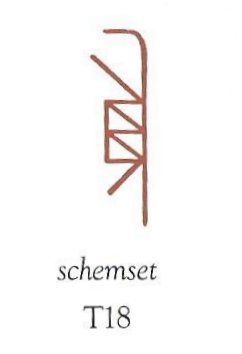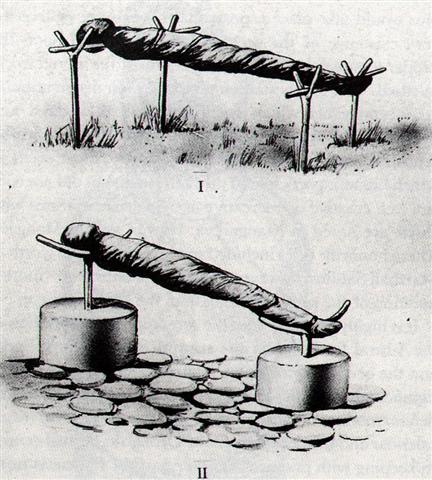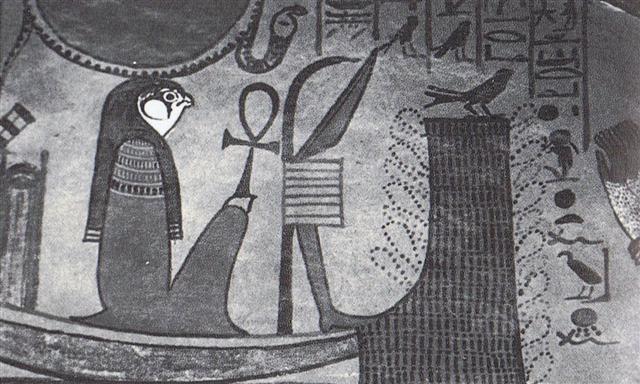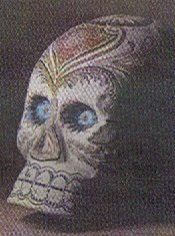Adding 16 to 348 gives the result 364, but when counting time 347 + 16 = 363 (= 3 * 11 * 11). There are plenty of hanging 'fruits' ('11') in the first 16 glyphs of line Ga8. But they began to appear already at the midnight culmination of Hamal:
Offspring ('fruits', hua) can alternatively be 'descendants', referring to roots which also are inclined downwards. This distinction could be due to a worldview with a pair of hemicycles instead of a single year. The Egyptian schemset type of glyph (T18 in Gardiner's list) could perhaps have been used for both 'fruits' and for 'roots':
This picture is from the 8th hour down in the Underworld (source Wilkinson), although there are 6 schemset signs. I guess the idea was to illustrate how the 'sky hemisphere' of the year had 6 hanging 'fruits', drawn in front of the threatening knives. Knives came first and when a tree felt it was close to death it would speedily produce much offspring, this fact was certainly known in the ancient agricultural world. ... The king returns to power with the sun. Whereas, over the next two days, Lono plays the part of the sacrifice. The Makahiki effigy is dismantled and hidden away in a rite watched over by the king's 'living god', Kahoali'i or 'The-Companion-of-the-King', the one who is also known as 'Death-is-Near' (Koke-na-make). Close kinsman of the king as his ceremonial double, Kahoali'i swallows the eye of the victim in ceremonies of human sacrifice ... The example schemset (T18) glyph above appears to be oriented in the wrong direction, but its 'package' is divided into twice 4 = 8 and not into 6. In front of and below these 6 hanging sky heads are signs of cloth (menchet, S27).
I suggest the single hanging head in Cb1-5 should be read together with the close by Al Ghafr (the Covering), the 13th Arab station for the Sun.
There is no hanging 'fruit' down in the Underworld in front of Horus, instead there is an amputated leg ('descendant') at schemset. Wilkinson comments this feature as a word joke where 'the handle' has been drawn out into an outstretched human leg resting on the deck of the ship. This could then be read out as 'companion' (the established meaning for the otherwise strange schemset):
However, such a word joke should not be allowed to hide from us the basic meaning. The 'package' has 7 layers, not 6 as when there is a head up high. ... Another year passed, and a man by the name of Ure Honu went to work in his banana plantation. He went and came to the last part, to the 'head' (i.e., the upper part of the banana plantation), to the end of the banana plantation. The sun was standing just right for Ure Honu to clean out the weeds from the banana plantation. On the first day he hoed the weeds. That went on all day, and then evening came. Suddenly a rat came from the middle of the banana plantation. Ure Honu saw it and ran after it. But it disappeared and he could not catch it. On the second day of hoeing, the same thing happened with the rat. It ran away, and he could not catch it. On the third day, he reached the 'head' of the bananas and finished the work in the plantation. Again the rat ran away, and Ure Honu followed it. It ran and slipped into the hole of a stone. He poked after it, lifted up the stone, and saw that the skull was (in the hole) of the stone. (The rat was) a spirit of the skull (he kuhane o te puoko). Ure Honu was amazed and said, 'How beautiful you are! In the head of the new bananas is a skull, painted with yellow root and with a strip of barkcloth around it.' Ure Honu stayed for a while, (then) he went away and covered the roof of his house in Vai Matā. It was a new house. He took the very large skull, which he had found at the head of the banana plantation, and hung it up in the new house. He tied it up in the framework of the roof (hahanga) and left it hanging there ...
I suggest we may have found the reason for the peculiar curve at the top end of the nuku figures, a feature which is beginning with night 200 (glyph 199). The Hindu heliacal location was Mula, bunch of roots tied together, which seems quite similar to a schemset package. The Mula package was ruled by 8 stars (ε, ζ, η, θ, ι, κ, λ, and μ Scorpii), beginning with ε (Wei, Tail) and ending with Apollyon (ι). Although I think there was also a 9th star (which would suit the position down in the Underworld): ... Lesath, or Lesuth, is from Al Las'ah, the Sting, which, with λ, it [υ] marks; yet Smyth, who treats of these two stars at considerable length, says that the word is formed by Scaliger's conjecture from Alascha, which is a corruption of al-shaúlah. Lesath, therefore is not a term used by the Arabs, who designate all these bumps, which form the tail, Al-fiķrah, vertebrated twirls; they are formed by ε, μ, ζ, η, θ, ι, κ, λ, and υ, and it is supposed that the sting, punctura scorpionis, was formerly carried to the following star, γ, marked nebulous by Ptolemy. But this γ is surely wrong; that letter really applying to a star in the right claw very far to the west of the sting, - as far as the make-up of the creature will allow. Still Burritt located it as Smyth did. Al Bīrūnī wrote that λ and υ were in the Harazā, the Joints of the Vertebrae. Riccioli mentioned υ as Lesath vel potius Lessaa Elaakrab Morsum Scorp, vel Denneb Elaakrab; and Bayer, Leschat recté Lesath, Moschlek, Alascha, which we have seen for λ; but the proximity of these stars renders this duplication not unnatural ... What a mess! I cannot find any γ Scorpii. Neither in Wikipedia, nor in my astronomy book, nor in Cartes du Ciel. But a reasonable candidate is G (as in gamma) Scorpii, the very last part of the tail (thus a 'following' star). We must add G to our list ... G Scorpii is Basanismus, rising the day after Apollyon.
The 3 Rogo figures have 6 small mata ('berries') inside below (in the Underworld). On Easter Island the Full Moon was at He Maro, the winter solstice month south of the equator:
The journey in the Underworld evidently continued for at least 16 nights:
The 'hanging fruit' sign is a variant of hua poporo:
... The state of the tree loomed large in their thoughts, because it came about at the same time the head of One Hunaphu was put in the fork. The Xibalbans said among themselves: 'No one is to pick the fruit, nor is anyone to go beneath the tree', they said. They restricted themselves, all of Xibalba held back. It isn't clear which is the head of One Hunaphu; now it's exactly the same as the fruit of the tree. Calabash came to be its name, and much was said about it. A maiden heard about it, and here we shall tell of her arrival. And here is the account of a maiden, the daughter of a lord named Blood Gatherer. And this is when a maiden heard of it, the daughter of a lord. Blood Gatherer is the name of her father, and Blood Moon is the name of the maiden. And when he heard the account of the fruit of the tree, her father retold it. And she was amazed at the account: I'm not acquainted with that tree they talk about. It's fruit is truly sweet! they say, I hear, she said. Next, she went all alone and arrived where the tree stood. It stood at the Place of Ball Game Sacrifice. What? Well! What's the fruit of this tree? Shouldn't this tree bear something sweet? They shouldn't die, they shouldn't be wasted. Should I pick one? said the maiden. And then the bone spoke; it was there in the fork of the tree: Why do you want a mere bone, a round thing in the branches of a tree? said the head of One Hunaphu when it spoke to the maiden. You don't want it, she was told. I do want it, said the maiden. Very well. Stretch out your right hand here, so I can see it, said the bone ... |
|||||||||||||||||||||||||||||||||||||||||||||||||||||||||||||||||||||||||||||||||||||||||||||||||||||||||||||||||||||||||||||||||||||||||||||||||||||||||||||||||||||||||||||||||||||||||||||||||||||||||||||||||||||||||||||||||||||||||||||||||||||||||||||||||||||||||||||||||||||||||||||||||||||||||||||||||||||||||||||||||||||||||||||||||||||||||||||||||||||||




























